Callisto Occults/Eclipses Europa,
Comet Lovejoy in Cassiopeia, M65/M66 Galaxies
Posted: 16 March 2015
Cloudy skies returned after the last session on Tuesday. On Friday, the 13th of March, a neighbor had some bad luck. The day was partly cloudy, with occasional light breezes. Then about 1400 MST, a brief strong wind came up and I heard a very loud noise. I thought maybe our trash bin or one of our compost barrels had blown over. I checked and they were OK. A little later I was driving out to do an errand and another neighbor mentioned that she had seen a microburst or large dust devil come through and it picked up the roof of a neighbor's carport. As I passed that neighbor's house I could see that the roof was at a strange angle and that one of its support poles (about 3" in diameter) had hit their house. The base of the supporting structure by their house was about 3' above the ground and was resting against one of their vehicles. Another support post had damaged another of their vehicles that was under the carport roof. I didn't see any other damage in the area. When I got back home I checked more around our place and didn't even find any broken trees limbs. Obviously a very isolated wind event.
The sky dawned clear on Saturday, 14 March, with strong winds developing in the morning. Unfortunately, unproductive (no rain) clouds began appearing mid-day. Sunday dawned mostly clear and still windy, but clouds began appearing in the west mid-day. Fortunately, the clouds moved on, although the winds continued throughout the afternoon.
|
Open: Sunday, 15 March 2015, 1741 MST Temperature: 81°F |
Session: 793 Conditions: Mostly clear, breezy |
Synced observatory clock to WWV for the night's Jupiter Moons Mutual Events. 1755 MST: viewed Venus, 83X. Gibbous phase visible against bright blue sky.
Slewed to Jupiter. No moons visible yet (sky too bright). Callisto would begin occulting Europa just one minute after sunset. Magnitude change would be 0.81. Mounted D7000 DSLR at prime focus + 3X TeleXtender and focused on Jupiter. Seeing was not very good. 1804 MST: ready to image occultation. 1826 MST: could now seeing three moons on camera Live View screen. 1832 MST: sunset. Occultation began at 183332 MST and ended at 184411 MST. This cropped frame from an HD video, 1/30sec, ISO 2500, shows the four Galilean Moons, with Callisto and Europe very close together:

The sequence of cropped images from the HD video shows the occultation occurring:
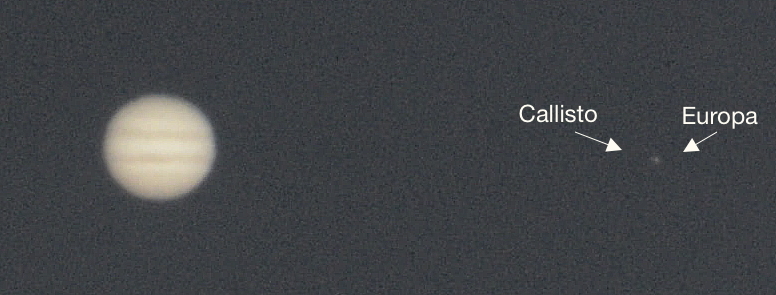

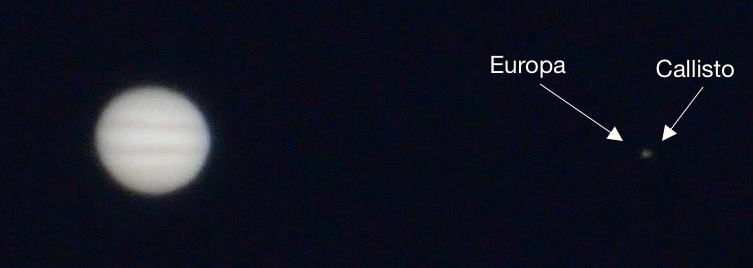
Poor seeing and the bright sky just after sunset hindered imaging.
After the occultation was over I began setting up to photograph Comet C/2014 Q2 (Lovejoy) in the constellation of Cassiopeia. I mounted the D7000 DSLR on the LXD55 tripod on the observatory patio:
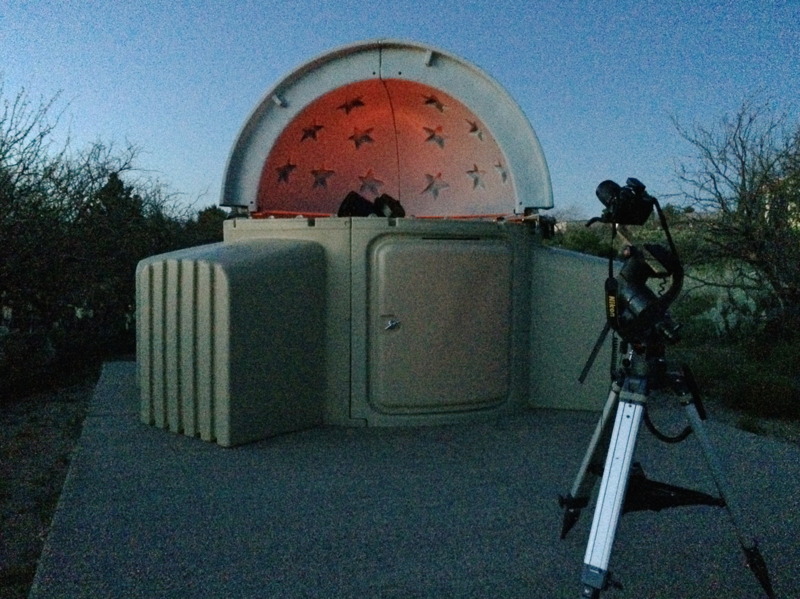
1918 MST: began searching for the comet using 12x70 binoculars. It was easily seen 33 minutes before the end of astronomical twilight near the star Ruchbar (Del Cas). I slewed the 8" LX200-ACF to Ruchbar; Comet Lovejoy was in the field-of-view using 83X. 1938 MST: the Zodiacal Light was easily seen in the western sky.
I did a focus test using Venus with the DSLR Bahtinov Mask. I then did some framing test exposures trying to get the best view of the constellation and surrounding objects. This slightly cropped f/4.2, 2 minute, ISO 5000, FL 34mm, photo shows M31 (Andromeda Galaxy), the Double Cluster, the constellation of Cassiopeia, and Comet Lovejoy. Mouseover (or tap) the image to see labels.
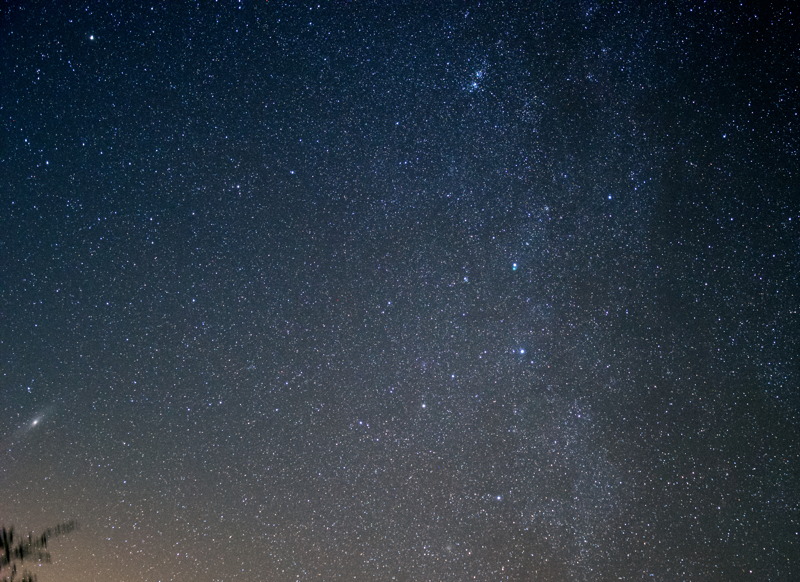
Mouseover or tap on image for labels
2012 MST: ended comet imaging. 2016 MST: viewed Comet Lovejoy in the 8" telescope, 83X. The bright nucleus was visible, surrounded by a large green coma.
Then slewed to M65 (galaxy), my first DSO target for the night. Mounted the D7000 DSLR at prime focus using an extender and off-axis guider, and then did a focus test on the star Regulus using the 8" Bahtinov Mask. Slewed back to M65 and found a good guide star. Did a 1 minute ISO 5000 framing test exposure. Framing was not ideal but I accepted it. This cropped, guided 10 minute, ISO 5000, exposure of M65 was processed using Neat Image:
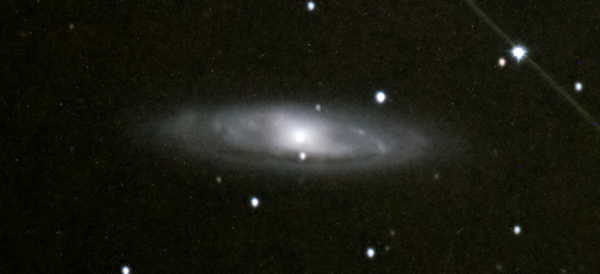
(Caught a satellite going through the FOV.)
Slewed to M66 (galaxy), found a guide star, and did a framing test exposure. Processed this cropped, guided 10 minute, ISO 5000, exposure in Neat Image:
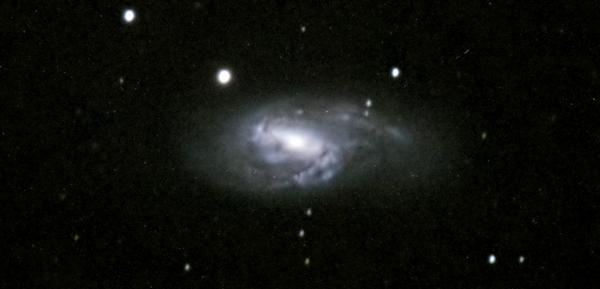
2126 MST: ended DSO imaging.
2143 MST: did some DSO observing, 83X. Started with a tour of some galaxies in Leo: NGC2903, M95. M96. NGC3377, M105, M65, NGC3626, M66, and NGC3628. Then viewed M51 (Whirlpool Galaxy), M81 (Bode's Galaxy), M82 (Cigar Galaxy), and M101 (Pinwheel Galaxy).
2210 MST: viewed Jupiter using the 12x70 binoculars. The four Galilean Moons were visible. 2215 MST: viewed Jupiter, 83X, then switched to 222X. Seeing was not very good, but the moons were nicely spread out across the field-of-view. Returned to 83X.
2225 MST: began setting up to image the next Jupiter Moons Mutual Event: Callisto shadow eclipsing Europa. This composite image taken at 2305 MST shows the moons:

The Great Red Spot is just visible at the upper left limb of Jupiter.
The eclipse of Europa began at 234624 MST and ended at 235837 MST. These three cropped images taken from the HD video recording, 1/30sec, ISO 6400, prime focus + 3X TeleXtender, show Europa before, mid-eclipse, and after the eclipse:
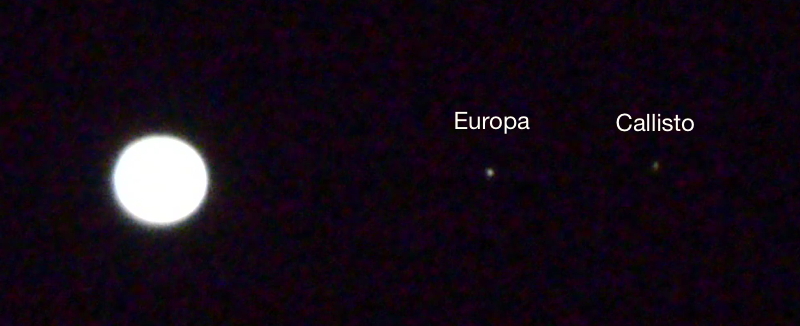


During the eclipse, especially at mid-eclipse when the magnitude change was 0.95, the dimming of Europa was easily seen on the D7000 DSLR Live View screen.
|
Close: Monday, 16 March 2015, 0011 MST Temperature: 55°F |
|
Comments are welcome using Email. If you are on Twitter you can use the button below to tweet this report to your followers. Thanks.
Cassiopeia Observatory Home Page
Copyright ©2015 Michael L. Weasner / mweasner@me.com
URL = http://www.weasner.com/co/Reports/2015/03/16/index.html
